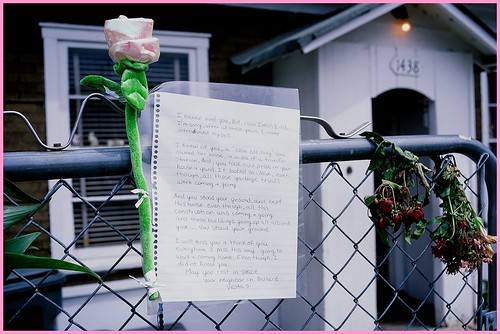Reinventing Edith Macefield
April 22, 2014 at 5:21 am | Posted in Uncategorized | Leave a commentTags: ballard, edith macefield, nail houses, seattle, story ideas, writing
Recently somebody randomly contacted me through Flickr about my 2008 photos of Edith Macefield’s house. [I happened to be visiting Seattle the week after Macefield’s death and I went by there and had a look at some notes people had placed outside her house.] They were looking for info about Macefield for an article in the Architecture section of a Czech web site.
This is what I wrote to them [hastily, including every grammar and sentence construction mistake in the book]:
I didn’t know who Edith Macefield was but I noticed her house for the first time in 1988 while working at an architectural firm a couple blocks away. The Seattle neighborhood was really a mixed bag — charming but gritty mix of industrial waste, marine infrastructure and support businesses, auto shops, vacant lots overgrown with blackberry vines and cars rumbling over the 1912 vintage Ballard bridge. Her tiny, square house with pyramid-shaped roof and little dormers was modest and well kept. There was a blue Chevy compact parked on the street in front of the house. A small yard, a tree and a clothes line; and rose bushes behind a low wire fence.
In 2008 I learned a lot more about Macefield when her story was publicized in the news media. She put up with a lot of changes in the decades in the house — a warehouse next door became a refuse transfer facility, then an abandoned, graffiti covered eyesore. Homeless people roamed the streets and camped out in old RVs under the bridge. Still, I can totally see why she stayed. The house was well sited on a low traffic side street, just far enough from the bridge so the noise wasn’t too annoying. Great south facing sunny lot.
She became a local and then national folk hero by refusing to sell out to the mall developer. As much as $750,000 was offered, as I recall, but Macefield said the place was priceless to her.
One of the aspects of Seattle I really appreciate, and part of what makes it a great place on Earth [despite all the changes] is that by and large they have allowed the old and new parts of the city to mingle and co-exist. At least this has been the case lately and for a while now. Perhaps this partly resulted from a rather overzealous approach to redevelopment that prevailed from the late 19th century at a furious pace through the 1930s, and to a lesser extent until the mid-1960s. The tidelands between downtown and West Seattle were filled in, the forests of Ballard and the North End knocked down, creeks undergrounded/ducted, the Duwamish River was channeled, and a series of street regrade projects ensued including the destruction of Denny Hill [chronicled in the novel ‘Madison House’]. Later the demo of lots of downtown buildings along the route of Interstate 5 fomented another round of growth shock — the Pike Place Market [the most famous and loved Seattle landmark] narrowly escaped the wrecker’s ball in this period.
I don’t really know but assume all this contributed to people being in less of a hurry to mow down everything that’s old and in the way.
And that was why, in a few days following her death, scores of people who didn’t know Macefield stopped by her house to leave anonymous notes on her fence expressing admiration for her steadfastness and lack of greed and crass calculation; and for having the good sense to know when she had a good place and sticking with it through good times and bad.
And recently I received a follow-on message with a link to the resulting article. It loses something in translation but is still compelling and, um, sort of hilarious!
Reflecting on it more, I am starting to think we are all getting Macefield wrong. It’s been difficult to find out anything about her via casual reading around on the web. She was 83 when she became a story. And by most accounts, she didn’t care for the attention. Perhaps she felt like she was living in a ‘Twilight Zone-ish, end up in hell’ scenario where she was surrounded by people who had lost their minds? She was doing fine with her books and her opera records and probably just wished everyone would leave her alone. Certainly wouldn’t care about hipster tattoo tributes to her tenacity and principles.So I am considering trying to dig a little deeper, and write a story about her house and property with less emphasis on what happened after 2006, and more about the 106 years the house was there before 2006.
10-22-10 [from the archives, May 2006]
October 26, 2010 at 3:20 pm | Posted in architecture and design, photo du jour, Uncategorized | Leave a commentTags: ballard, beach house, daily photo, history, house, seattle, seaview ave.

Beach house, Seaview Ave., Ballard, Seattle.
Blog at WordPress.com.
Entries and comments feeds.

